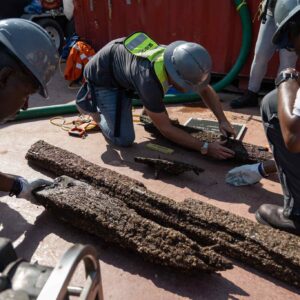For the past five years, Diving With a Purpose has been involved in the search, survey and documentation of the Clotilda shipwreck. The Clotilda was the last ship involved in the Transatlantic Era of African Enslavement (TEAE) that brought captured Africans into the USA illegally in July 1860. In July 2018, DWP collaborated with SEARCH, Inc., the Alabama Historical Commission and the National Museum of African American History and Culture Slave Wrecks Project to confirm the location of the Clotilda shipwreck by performing side-scan sonar, magnetometer and sub-bottom profiler archaeological surveys (See Photo 1).
The location of the wreck was confirmed in May 2019 in a section of the Mobile River on the east side of Twelve Mile Island. A more comprehensive survey of the wreck site was performed in May 2022. A total of 94 artifacts were collected from the site during this field mission. Each artifact removed was documented and cataloged. Ninety of the artifacts were returned to the wreck and four were held for further conservation, including a pulley mechanism shown in Photo2.








